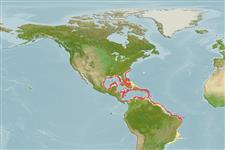Preferred temperature (Ref.
115969): 13.3 - 22.7, mean 18.3 (based on 73 cells).
Phylogenetic diversity index (Ref.
82804): PD
50 = 0.5625 [Uniqueness, from 0.5 = low to 2.0 = high].
Bayesian length-weight: a=0.01698 (0.01384 - 0.02083), b=2.93 (2.87 - 2.99), in cm Total Length, based on LWR estimates for this species (Ref.
93245).
Trophic level (Ref.
69278): 4.2 ±0.57 se; based on food items.
Resilienza (Ref.
120179): Medio, tempo minimo di raddoppiamento della popolazione 1.4 - 4.4 anni (K=0.29-0.61).
Prior r = 0.24, 95% CL = 0.16 - 0.36, Based on 1 data-limited stock assessment.
Fishing Vulnerability (Ref.
59153): Low to moderate vulnerability (34 of 100).
